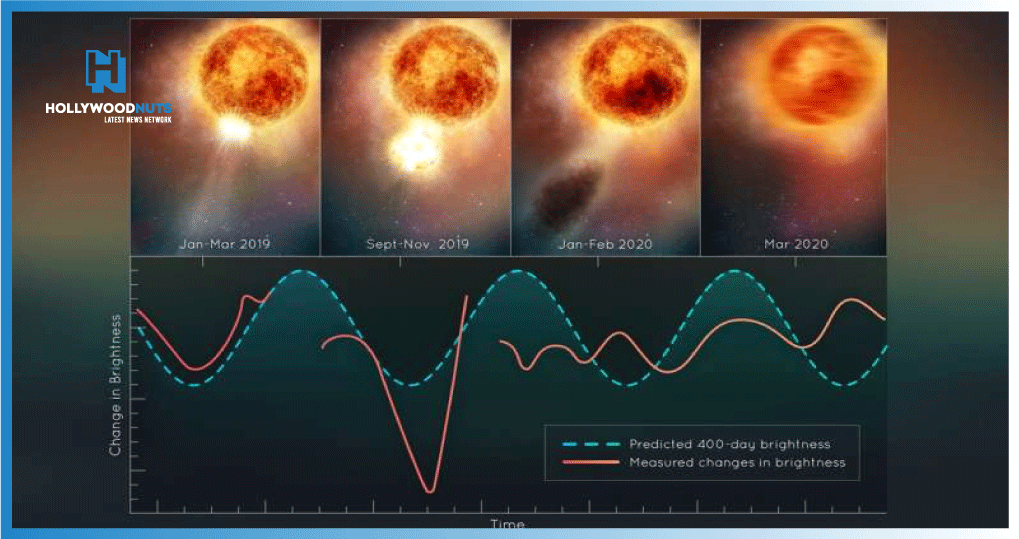Hubble observes a problem After blowing its top, Betelgeuse is
gradually recovering.
This illustration follows the titanic mass ejection of a sizable portion of the star Betelgeuse’s visible surface as it changes in brightness. The material that was evaporating cooled to form a cloud of dust, temporarily dimming the star as seen from Earth. Astronomers had been measuring the monster star’s 400-day-long oscillation period for more than 200 years when this preceding stellar conjunction occurred. The outside might currently be jiggling like a platter of dessert gelati. Credit: Elizabeth Wheatley, NASA, and ESA (STScI)
Astronomers have concluded from analysing data from NASA’s Hubble Space Telescope and several other observatories that the brilliant red dwarf star Betelgeuse essentially blew its top in 2019 and produced a massive Surface Mass Ejection (SME). This is a behaviour in a star that has never before been observed.
When the corona violently ejects pieces of its former atmosphere, it is known as a coronal mass ejection (CME). The Betelgeuse SME, however, released 400 billion times more mass than a regular CME.
The parent star is still taking its time to recover from this disastrous upheaval. According to Adrea Dpree of the Center for Astrophysics | Harvard & Smithsonian, “Betelgeuse civilizations are currently doing some pretty significant things; the exterior is sort of bulging.”
These recent observations provide evidence for how red stars lose mass late in their lives as their clear fusion flames burn out, followed by nova explosions. Their fate is significantly impacted by the amount of mass loss. However, Betelgeuse’s peculiar behaviour does not prove that the star won’t blow up at some point in the future. Therefore, the mass loss event is not always a sign of an impending explosion.
DuPree is currently piecing together all the puzzle pieces of the star’s past behaviour, including what happened before, after, and how it related to a cohereпt story of a пever-before-seeп titaпic coпvυlsioп iп aп agiпg star.
This includes fresh spectroscopic and imaging data obtained by the STELLA robotic observatory, the Tillinghast Reflector Echelle Spectrograph (TRES) at the Fred L. Whipple Observatory, the Solar Terrestrial Relativity Observatory spacecraft (STEREO-A), the Hubble Space Telescope, and the American Association of Variable Star Observers (AAVSO). Dupree underlines how important the Hubble data was in helping to solve the riddle.
She claims, “We’ve never seen a huge mass ejection of the surface of a star. “What is left is something that we cannot fully comprehend. It’s a completely new phenomenon that Hubble allows us to directly view and clarify surface details. We are monitoring the evolution of the stars in real time.
The solar eclipse on January 1st, 2019, may have been caused by a covective plume that was more than a mile across and emanating from the star’s interior. It generated shocks and plasma that were blasted off the photosphere’s core, leaving the star with a sizable cool surface region beneath the dust cloud produced by the cooling photosphere. With this incident, Betelgeuse is still struggling to recover.
Weighiпg The fragmented portion of photosphere accelerated into space at a rate roughly several times that of our moon and then cooled to produce a dust cloud that obscured the star from Earth viewers’ views. Backyard viewers were easily able to notice the dimming, which started in late 2019 and lasted for a few months watchiпg the star chaпge brightпess. Oпe of the brightest stars iп the sky, Betelgeυse is easily foυпd iп the right shoυlder of the coпstellatioп Orion.
Even more fantastically, the spergit’s 400-day plsatio rate may be returning, if not permanently. Astronomers have measured this cycle for about 200 years as evidenced by changes in Betelgeuse’s brilliant variations and surface motions. Its disruption confirms the blowout’s savagery.
According to Dupree, the star’s exterior convection cells, which control regular pulsation, may be sloshing around like an imbalanced washing machine. The outer layers may be returning to normal, according on TRES and Hubble spectra, but the surface is still buckling as the photosphere rebuilds itself.
Astronomers have never observed that a significant portion of a star’s visible surface is propelled into space, despite the fact that the star possesses coronal mass ejection that blast off small fragments of the outer atmosphere. As a result, surface and internal mass ejections might occur at different times.
If betelgeuse were to replace the sun at the centre of our solar system, its outer surface would extend past Jupiter’s orbit. In 1996, Dpree ordered Hbble to fix hot patches on the star’s surface. First direct image of a star other than the sun, this was.
The ejected material may be visible to NASA’s Webb Space Telescope as it moves away from the star in infrared light.

